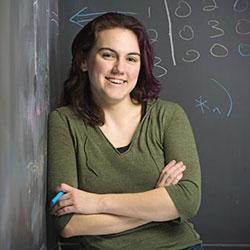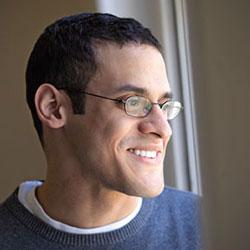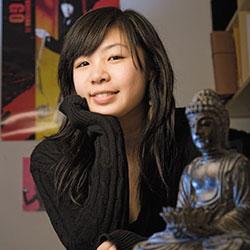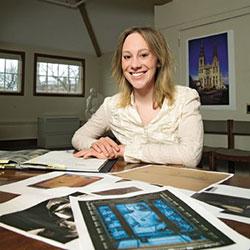Raising the Bar
By Emily Gold Boutilier
Writing a senior thesis takes focus, imagination, a high threshold for pain—and also sheer pluck. Each spring, close to half of the class decides to take the leap. Working in nearly every academic department, around 200 Amherst seniors this year produced lab reports, theoretical studies, original poems and paintings. Ten music majors—more than ever in recent memory in a single year—wrote or performed a senior project. Many theses crossed disciplines: One student merged his interests in history, Spanish and science for a paper on land reform in Mexico. Another worked in the psychology and chemistry labs to test common insecticides.
What follows is not intended to be a comprehensive tally of the best theses of the year, nor to represent the makeup of the Class of ’07. Rather, it is a small sampling of high-quality work from a range of disciplines, by students with various interests, backgrounds and talents. Some of these students are athletes; some are activists. Some hope to be physicians; others to teach. All have approached their senior projects with creativity and drive. “I knew if I didn’t do it, I’d regret not going as far as I could,” says Kelly Eng ’07, whose women’s and gender studies thesis is on Chinese goddesses. “It’s such a culmination of all the work you do here.” Mark Yarchoan ’07, a neuroscience major, researched his thesis, on a strange phenomenon in nerves, “to see what I could do on my own.” Below are short portraits of some of these new graduates.
 |
Name: Amos Irwin ’07
Majors: History and physics
Hometown: Palo Alto, Calif.
Activities: Captain, Ultimate Frisbee team; cofounder, Sudan Divestment Project Immediate plan: Teach for America or U.S. State Department Critical Language Scholarship in Tajikistan
Irwin is a history buff who speaks four foreign languages and has a knack for science. His thesis reconsiders a 1936 land reform project in the Laguna region of northern Mexico. The reform transformed much of the area into collective farms, known as ejidos. But by 1946, while private farms saw profits, half of the ejidos in the region had accumulated so much debt that the bank had cut off their lines of credit. Scholars have since deemed the reform a failure, blaming either population growth or the collective model itself.
Irwin takes a fresh look. Over Interterm, with a grant from the Alpha Delta Phi Fund, he spent three weeks in Mexico poring over Spanish-language newspaper articles, letters and federal land and water reports. He discovered that the government set water policies to benefit private farms. “The state made the collective farmers get water from the rivers,” he says. “But the rivers suffered too many droughts to support the farms.” Irwin argues that state practices combined with land and soil problems to “close in on all sides of the ejidos.”
Irwin titled his project “Well, Dam: Mexican Water Policy and the Ejidos of La Laguna, 1936-1964.” His adviser, Assistant Professor of History Rick López ’93, calls the thesis outstanding and original. “By looking at the environmental factors,” López says, “he’s come up with a very innovative interpretation.”
 |
Major: Math
Hometown: Babylon, N.Y.
Activity: Orchestra manager
Immediate Plan: Graduate school in math
“One of the important ideas in set theory,” explains Professor of Mathematics Daniel Velleman, “is that infinity comes in different sizes.” What are called “large cardinals” are very large sizes of infinity. Cotter’s thesis is about set theory, large cardinals and a mathematical puzzle.
In 1992, mathematicians proved that by assuming a hypothesis that involves large cardinals, they could solve a certain word problem in algebra. “Which is weird,” Cotter says: large cardinals should have nothing to do with algebra. “It’s unexpected,” she says, “and it’s really kind of neat.”
Working with adviser Jim Henle, a professor of mathematics at Smith College and an expert on large cardinals, Cotter studied and tied together the small, esoteric body of literature on the algebra solution. Her thesis is the first to explain, comprehensively, why the proof works.
To this day, no mathematician knows whether one can prove the algebra problem without large cardinals. In an effort to find out, Cotter and Henle tested the problem on a smaller system of math, hoping to show that it wouldn’t work. “We haven’t been able to show that,” Cotter says. But they’ve made progress: “I’ve covered a few white boards in really interesting equations, trying to crash through some of this stuff.”
 |
Name: Khira Jordan ’07
Major: English
Hometown: Beverly Hills, Calif.
Activity: Senior music director, WAMH radio
Immediate plan: English teacher in rural France
Jordan read the 1891 novel Tess of the d’Urbervilles, by Thomas Hardy, in 10th grade. “From then on,” she says, “I’ve been completely swept up in 19th-century British literature.” When she arrived at Amherst, she dutifully studied across disciplines, all the time knowing she’d settle down as an English major. Indeed, she did.
In English courses, Jordan first nurtured her interest in Victorian England. Then, as she writes in her thesis, she discovered Henry James, “that nationally and historically piebald author belonging at once to America and England, to both the 19th and 20th centuries.”
Jordan’s thesis is about the representation of consciousness in the late work of James. She focuses on James’s final novel, The Golden Bowl (1904), and the last volume of his three-part autobiography, The Middle Years (1917). She looks at how James’s characters “almost split their subjectivity into two pieces,” she says, “where they’re sort of able to narrate themselves as if they’re two different consciousnesses.”
As her adviser, Professor of English Andrew Parker, points out, late James does not make for easy reading. “It may feel like you’re slogging through molasses,” he says. “It is not most people’s idea of a good time.” And yet, Parker says, the complexity is exactly what attracted Jordan—one of the most well-read students he’s ever met—in the first place.
 |
Name: Mark Yarchoan ’07
Major: Neuroscience
Hometown: Bethesda, Md.
Activity: Photography editor, The Olio
Future plan: Medical school
Over the years, many a thesis student has worked with Stephen George, the Manwell Family Professor in Life Sciences, to understand a strange phenomenon known as supernormality, in which a nerve’s second electrical impulse travels faster than its first.
On a hunch, the professor suggested that Yarchoan investigate gap junctions, which are tiny passages that allow ions to travel freely between cells. “When I started this project,” says Yarchoan, whose father is Robert ’71, “almost everything else had been ruled out.”
For his thesis, Yarchoan bathed earthworm nerve cords in a solution that included deuterium oxide (water with two additional neutrons), which is known to close gap junctions. The experiment worked: with the little passages closed, supernormality decreased dramatically, thus linking gap junctions with the phenomenon—at least in earthworms. (In humans, the cause appears to be different.)
George has spent much of his career studying the larger issue of hyperexcitability, when nerves fire too many impulses. In humans, hyperexcitability can relate to seizure disorders. George calls Yarchoan’s work “a big step” forward, while insisting it would have been perfectly helpful to rule out gap junctions as a factor. “But it’s always cool,” the professor allows, “when something works out.”
 |
Name: Honora Talbott ’07
Major: Theater
Hometown: McLean, Va.
Activity: Member, Mr. Gad’s House of Improv
Future plan: Actor
For theater and dance majors, a senior project is not a choice but a requirement. Such a project might entail acting in a role, writing a script, choreographing a dance or directing a play. Each year, the department builds its season around these projects, staging each one. Faculty members serve not only as advisers but also as actors, directors and producers. At first, Talbott, an actor, wanted to perform a one-woman show. Then, hoping to stretch her abilities, she thought, “Why don’t I write it?”
Talbott wrote and performed Halfway ’Round the Circle about a woman, Robin, with Borderline Personality Disorder. It evolved into a two-person play. In 21 vignettes, it follows Robin from young adulthood to middle age as she spirals downward into a raw state of despair and struggles to decide whether the costs of healing are really worth it. “It was the hardest acting challenge I’ve ever had,” Talbott says.
She played the four female roles; Brian Lewis ’08 played the six male characters. Talbott’s acting adviser, senior resident artist Peter Lobdell ’68, directed. The show ran in March. “I was afraid that people would think it was melodramatic or too intense,” Talbott reveals. She need not have worried: Circle won raves in the Amherst Student and among friends. “As an actor,” she says, “I got braver.”
 |
Name: André Pérez ’07
Major: Political science
Hometown: Bronx, N.Y.
Activity: Member, Liberty in North Korea
Future plan: “Every couple of months, I change my mind.”
In March, Pérez was part of a small group from Amherst to have dinner with former Brazilian president Fernando Henrique Cardoso, who was on campus to give a speech. Pérez used the occasion to do primary research: he asked how often, while in office, Cardoso thought about financial catastrophe. The former head of state, according to Pérez, said the worry was always on his mind.
Pérez wasn’t surprised. His thesis looks at why and to what extent Latin American presidents renege on campaign promises to increase spending for education, health care and the like. For some U.S. politicians, taxing and spending is political suicide, but heads of developing states have deeper fears: that investors will pull out money, that bond ratings will plummet, that economic catastrophe will ensue. Pérez developed a theory he calls “mandate deviation” to look at actions that stray from words. He argues that the degree to which Latin American presidents go back on promises depends on the force of their political party. The backing of a strong party makes it easier for a president to renege. Pérez used two current presidents—Venezuela’s Hugo Chávez and Brazil’s Luiz Inácio Lula da Silva—as case studies.
Associate Professor of Political Science Javier Corrales says that Pérez, his advisee, is an eager learner: “He is the one who always feels that he ought to do more.”
 |
Name: Nitya Viswanathan ’07
Major: Biochemistry
Hometown: Tenafly, N.J.
Activity: Chapter chair, Habitat for Humanity
Immediate plan: Medical school
While still in high school, Viswanathan worked in a biochemistry lab at the Albert Einstein College of Medicine in New York City. At Amherst, she decided to become a doctor. “I really enjoy science,” she says. “I also like being able to interact directly with people. Medicine is the perfect combination of these two things.”
Viswanathan’s thesis relates to how cells talk—how one tells another, “I’m going to become a nerve cell” or “I’m going to become a kidney cell.” Specifically, Viswanathan studied a means of communication known as the Notch signaling pathway.
The Notch pathway is important in the development of all multicellular organisms, including humans. Scientists have much to learn about the way it works. In the lab, Viswanathan studied, in worms, four of the proteins involved in this pathway. She followed a mutant form of one of the proteins, hoping to see why it performs poorly and how it might function better. Her work provides the first-ever visual glimpse of that protein. Another one of the proteins, in addition to its role in the pathway, is linked to Alzheimer’s disease. Any research on that protein might someday help scientists better understand Alzheimer’s.
Viswanathan received a Beckman Foundation grant for her research. Her adviser, Associate Professor of Biology Caroline Goutte, describes her as persistent and optimistic. “Nitya,” she says, “is one of the happiest scientists I have met.”
 |
Name: Plamen Nenov ’07
Majors: Economics and math
Hometown: Gabrovo, Bulgaria
Activity: Resident, Russian Language Theme House
Immediate plan: Graduate school in economics
In Europe, where unemployment is high and labor laws are strict, many countries have tried to create jobs by making it easier to hire workers under short, fixed-term contracts. As the thinking goes, a temporary job is a stepping stone for the worker that also gives flexibility to the boss. Today, close to 15 percent of employees in Europe have such contracts.
Within Europe, national laws vary in the level of job protection they give to employees working under these temporary contracts and under the far more common permanent contracts. For his thesis, Nenov studied the effects of these differences. Nenov’s economic model includes workers searching for jobs and firms hoping to fill both low- and high-skilled openings.
Nenov found that when laws offer few protections to temporary workers but many to permanent ones, companies will opt to create short, fixed-term jobs, making it tricky for employees to find permanent work. The result is a labor market segmented into two groups: insiders with steady employment and outsiders who move from one temp job to the next. The outsiders are more likely to be low-skilled.
This model also shows what would happen if a nation were to relax or extend the term of temporary contracts, making Nenov’s thesis a potential tool for policy makers, says Visiting Assistant Professor of Economics John Gordanier, one of Nenov’s advisers.
 |
Name: Kelly Eng ’07
Major: Women’s and gender studies and Asian languages and civilizations
Hometown: Flushing, N.Y.
Activity: Member, Pride Alliance
Future plan: Event planner
When her grandmother died, Eng inherited a porcelain statue of Guan-yin, the Chinese goddess of mercy and compassion. Years later, while studying in China during her junior year at Amherst, Eng saw Guan-yin images everywhere—on small cards in churches, engraved on incense holders, as bronze figurines. To Eng, the elegant, powerful and womanly Guan-yin stood in stark contrast to commercial images of sexy, submissive Asian women in the United States. Eng soon learned that the Chinese were the first to portray the deity, who had started as a male god, in the female form. “I was surprised,” Eng writes in her thesis, “that such a feminine figure could hold so much power and respect in patriarchal China.”
Back at home, Eng decorated her room with images of Guan-yin. She began to wonder about other female deities and what they might reveal about femininity in China. For her thesis, Eng examined the origins and functions of Chinese goddesses, reading scholarly research, translations of ancient texts, even children’s books. Michele Barale, professor of English and women’s and gender studies, describes Eng, her advisee, as “a good thinker, a good writer and a very ambitious researcher.” Eng concluded that goddesses at once reinforce gender roles—the deities are always beautiful, for example—and give agency and power to everyday women.
 |
Name: Eric Glustrom ’07
Major: Biochemistry
Hometown: Boulder, Colo.
Activities: Varsity track and cross country; founder, Educate! (a charity supporting education in Africa)
Immediate plan: Co-executive director, Educate!
Glustrom’s mother, a scientist, once proposed to study whether common insecticides can mimic estrogen. Unable to get funding for the research, she put the question aside. For his thesis, Glustrom picked it up.
The question matters in part because studies link estrogen overexposure to breast cancer and to abnormal sexual development. Scientists already know that, in the test tube, two insecticides—the now-banned DDT and its modern-day replacement, methoxychlor—have certain metabolites that can bind to estrogen receptors. With a grant from the Beckman Foundation, Glustrom built on that finding. In the chemistry lab, he tested other DDT and methoxychlor metabolites— including some that no one had studied before. The result: the metabolites did bind to estrogen receptors, showing that the insecticide metabolites can indeed act like estrogen.
In the psychology lab, Glustrom tested the metabolites on rats. Surprisingly, the metabolites, for the most part, did not induce female sexual behavior in rats. Given the chemistry results, though, Glustrom would like to test the rats again, perhaps with a different dose of metabolites. He will continue the research over the summer. Associate Professor of Psychology Sarah Turgeon, one of Glustrom’s advisers, says, “It’s the first time that I’ve seen a student take on a thesis of this breadth as well as depth.”
 |
Name: Christianna Bonin ’07
Major: Fine arts and psychology
Hometown: Sidney, N.Y.
Activity: Co-captain, equestrian team
Future plan: Museum curator
Professor of Fine Arts Natasha Staller recently met a Ph.D. candidate in an eminent art history program. That student was studying Joseph Cornell, an eccentric and intractable 20th-century American artist. As Staller saw it, the graduate student was discovering nothing fundamentally new about Cornell. “I thought of Christianna’s work,” the professor says, “and smiled.”
Cornell is best known for creating shadowboxes and collages out of found objects. While other scholars have mentioned in passing that Cornell was a Christian Scientist, Bonin is the first to look deeply—with real specificity—into the artist’s faith. “On every imaginable level of form and meaning,” says Staller, who is Bonin’s adviser, “this turned out to be fundamental.”
Bonin studied Cornell’s unpublished letters, diaries and school papers. She took notes in front of his objects. She also dug into the collected papers of Mary Baker Eddy, the founder of Christian Science. “I discovered that Cornell’s artistic process resonates with Mary Baker Eddy’s attitude about healing,” Bonin says: Cornell saw it as a healing experience to transform everyday objects into works of art. Staller believes Bonin’s thesis will completely change the way scholars view Cornell. “This is Ph.D.-level research,” Staller says. “She has the fire.”
Name: Maria Millard ’07
Hometown: Orono, Maine
Major: Sociology
Activity: Tri-captain, track and field
Even though Maine is one of the poorest states in the nation, it has one of the top high school graduation rates, and its schools are consistently ranked among the country’s best. “It’s a poor state that does well,” Millard says. “It kind of defies the trend. So there must be something else at play.”
That something, she believes, is social capital. For her thesis, Millard surveyed close to 200 students at the University of Maine and did one-on-one interviews with first-generation college students from the state.
She found, among other things, that working-class high-school students whose friends are college-bound are less likely to drop out of school and more likely to go to college. “The power of friends is really enormous,” she says. “It makes sense: kids don’t want to be like their parents; they want to be like their friends.”
High schools in Maine tend to be small, Millard says, with fewer than 100 students in each grade. She argues that as a result, students are more likely to form tight bonds with their teachers and with one another. “Maine communities,” she says, “are really well connected.”
Millard is the fourth runner in her family to attend Amherst. The others are Peter Millard ’76, her father; Julie Millard ’84, her aunt; and Cameron Millard ’05, her brother.
Name: Amrita Vijayaraghavan
Hometown: Kent, Ohio
Major: Music
Activities: Member, symphony orchestra and jazz ensemble
In the Class of ’07, ten music majors—more than ever in recent memory in a single year—wrote or performed a senior honors project. John Radway ’07, for example, wrote a music-historical thesis on Gustav Mahler. Patrick Savage ’07 wrote an original composition in four movements for big band and choir, based on the Calvin and Hobbes comic strips.
Vijayaraghavan performed a South Indian Classical voice recital. She says her goal was to introduce the Amherst community to one of the classical arts of India. “It’s a very thriving tradition,” she says. She performed the piece on campus in April, and also gave a talk about the music’s structure. In addition, she wrote 20 pages of program notes that touch on the history and theory behind the music she performed.
Name: Ben Kaufman ’07
Hometown: Amherst, N.Y.
Major: Computer science
Activity: Glee Club
Kaufman’s thesis deals with a problem that arose out of the research of Assistant Professor of Mathematics Katherine Tranbarger. Tranbarger is a statistician who is working on a new technique for data analysis. “Her technique takes way too much time when implemented on a computer,” explains Professor of Computer Science Catherine McGeoch, who was Kaufman’s adviser.
Searching for a thesis topic, Kaufman learned about Tranbarger’s work. He decided to look at the problem from a computer science perspective, finding ways to speed up the data-analysis technique so that it takes seconds or minutes instead of years.
Emily Gold Boutilier is editor of Amherst magazine.
Photos: Samuel Masinter ’04